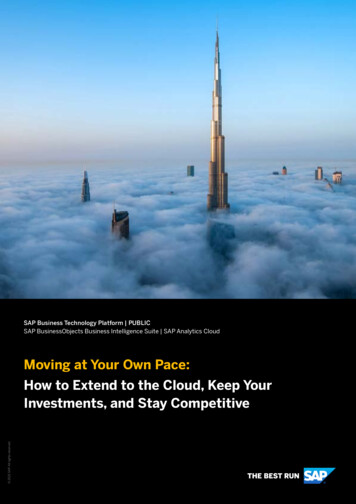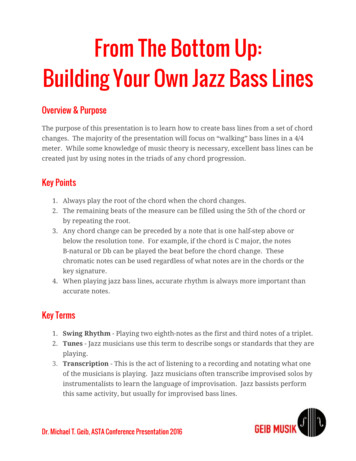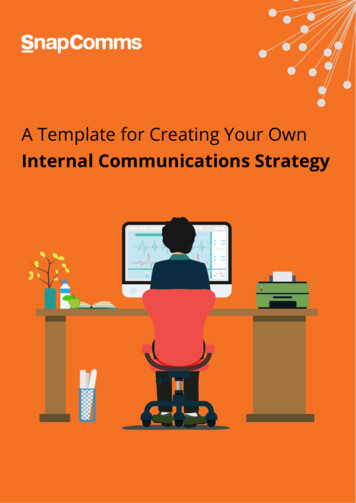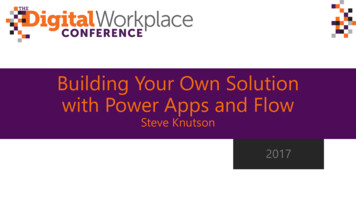
Transcription
SAP Business Technology Platform PUBLICSAP BusinessObjects Business Intelligence Suite SAP Analytics CloudMoving at Your Own Pace: 2021 SAP. All rights reserved.How to Extend to the Cloud, Keep YourInvestments, and Stay Competitive
Moving at Your Own Pace:How to Extend to the Cloud, Keep Your Investments, and Stay CompetitiveExecutive SummaryIt’s clear that cloud has firmly establisheditself as the new normal for enterprise IT.Successful enterprise leaders understand that it’snot a straightforward transition. Navigating thecomplexity of moving requires a uniqueapproach–as unique as your business itself.To think fast and move first, businesses require asingle source of truth to connect their enterprise.More often than not, that source of truth ispowered by the Cloud.We also know how important it is for businesseslike yours to keep pace with today’s competition.But while no one denies its versatility, fewunderstand the implications of moving over tothe Cloud.As someone who has made a large investment inyour deployment, we know that moving to theCloud is complicated and cannot be boiled down toa simple yes/no answer.Inside this eBook, we will cover the hybrid cloudapproach, its advantages and opportunities. We’llexplore use cases and pinpoint successes fromother businesses so you can see this strategy inreal life.2 / 24 2021 SAP. All rights reserved.
Moving at Your Own Pace:How to Extend to the Cloud, Keep Your Investments, and Stay CompetitiveTable of Contents02 Executive Summary13 Chapter 3:Fueling a Hybrid Approach with04 ForwardSAP Analytics Cloud06 Chapter 1:22 Chapter 4:On-premise and CloudHow to Extend to SAP Analytics Cloud09 Chapter 2:24 ConclusionHybrid Analytics: An IntegratedApproach3 / 24 2021 SAP. All rights reserved.
Moving at Your Own Pace:How to Extend to the Cloud, Keep Your Investments, and Stay CompetitiveForwardWhether they know it or not, manyenterprises today stand at a precipice.As more organizations are evaluating the featuresand benefits that a cloud platform offers, many arenaming moving to the Cloud as one of the mostimportant decisions a business can make for itsfuture. And as the technology continues to growfaster and more complex, so too does the pace ofthe market – and all its movers and shakers.That’s why an integratedexperience is the bestapproach for those wishingto start their journey tothe cloud. Ability to respond to changeA hybrid approach allows companies toexperience greater analytics capabilities, aswell as keep up with changing technology.And for organizations that strive to keep acompetitive advantage, it’s imperative toadopt a hybrid strategy. Insight to create a strategic planThis eBook is about how to do that.2020 showed us that those equipped with the righttools were able to thrive. Moving forward, it’s clearthat surviving in a fast, ever-changing environmentrequires businesses to have: One source of truth to base decisionmaking fromWhen businesses have these qualities, they’re ableto not only keep pace with the market, but they’realso agile enough to outpace their competitors.But few understand the implications ofmoving over to the Cloud.Factoring in the time, resources, capital, and yearsa business has put into its on-premise deployment,the benefits of the Cloud are often not enough topersuade an organization to move over.That puts businesses in a tricky position: how dothey tap into the technology they need to thrive,not just survive, without abandoning their historicaldata, investments, and internal processes?4 / 24 2021 SAP. All rights reserved.
Moving at Your Own Pace:How to Extend to the Cloud, Keep Your Investments, and Stay CompetitiveWhy You Should Read This BookHow to Use This BookThis book is a call to action for businesses to adopta hybrid strategy in response to a rapidly changing,competitive environment. The rise and prominenceof innovation is increasingly evolving. Machinelearning and Artificial Intelligence (AI) aregathering speed, and it won’t be long until it’smoved from the fringe and accepted as standardbest practice. Failure to adopt this technologydoesn’t just mean being one step behind–it risksbeing outpaced entirely.This eBook is your entry guide to a world ofpossibilities. It provides a solution so that you andyour business can make a confident decision andcarve a path forward.Who This Book is ForIf you’re just starting on your migration journey,we recommend beginning with Chapter 1 to get acomprehensive overview. Looking for moreinformation on the advantages of a hybridapproach? Jump to Chapter 3. To learn moreabout our program for SAP BusinessObjects BISuite customers to outline the journey to theCloud, then navigate to Chapter 4.It wasn’t that long ago that analytics wascomplicated and required training, time, andresources to move data through the enterprise.Now, analytics are for everyone, and information isreadily being shared.A note before we dive in: We know that the taskahead is complex and difficult. Change always is.But with that change comes valuable growth. Andif it feels difficult or uncomfortable, it’s a signyou’re headed in the right direction.Strategic thinking happens all over theorganization, so this book is for everyone. However,it’s particularly relevant for decision makers andleaders who are looking to understand not onlyhow a hybrid approach will be effective, but howto actually extend to a hybrid cloud architecture.Ready? Let’s begin.5 / 24 2021 SAP. All rights reserved.
Moving at Your Own Pace:How to Extend to the Cloud, Keep Your Investments, and Stay CompetitiveChapter 1On-premise and CloudA brief history of enterprise analyticsThrough the years, enterprise analytics has evolved andbecome more self-service oriented and dynamic, allowinganalysts and business users to create their own insights andinteract with them. But it wasn’t that long ago that enterpriseanalytics was complicated and slow.We can trace the history of enterprise analytics software backto the 1960s, with its roots deep in the manufacturing industry.During this time, manufacturers needed a better way tomanage, track, and control their inventory, and used basicsoftware to meet their scheduling, reconciling, and reportingneeds. The 1970s and 80s saw those same businessesadopting systems that grew more sophisticated, spanningmore departments and collecting even more data.Three decades later, enterprise analytics software became acommon presence in large companies. By the 1990s, systemswere able to expand beyond basic protocols and alignprocesses across all departments by mining a single source oftruth, setting the stage for enterprise resource planningsolutions we have come to know today.Today, enterprise analytics solutions are fully integratedsystems that can connect every aspect of your business inone place. These solutions provide businesses with a powerful,real-time tool that runs a single, shared database ofinformation that can be accessed by anyone in everydepartment across the enterprise.Employees from two different departments can both work offthe same set of accurate data and pull the relevant informationthat they need to do their jobs more efficiently and effectively.A modern-day enterprise analytics solution eliminates enteringthe same data multiple times into multiple systems orspreadsheets, providing you with a single source of truth foryour organization, and allows information to flow more freelybetween departments.6 / 24 2021 SAP. All rights reserved.
Moving at Your Own Pace:How to Extend to the Cloud, Keep Your Investments, and Stay CompetitiveCurrent LandscapeHow it StartedEven though enterprise analytics revolutionized entireorganizations and provided incredible efficiencies, it was ahefty investment with setup that required installation ofservers onsite, as well as hiring someone to configure,maintain, and secure the hardware on an ongoing basis.In addition, inflated cost of implementation and maintenancemade enterprise analytics only accessible to largercompanies.As well, as on-premise systems age, technology continues todevelop, which increases the cost to catch up with thecompetition with every passing year.For many, these problems persist today. Sticking with an onpremise investment is incredibly understandable: the time,resources, and training that went into this solution cannot beoverlooked. But in today’s world, businesses simply cannotcomplete on outdated or underachieving infrastructure.How it’s GoingIn the later 1990s, enterprise analytics software began tomove online as bandwidth and stable connectionsproliferated. Cloud server providers made it possible forbusinesses to run powerful applications and store enormousamounts of data in off-site, shared data centers.The advantages of the Cloud are obvious: it is more costeffective than their predecessors and provide amazingflexibility. Software could be installed quickly, businessescould access data from anywhere, and teams could respondto market changes with agility.But as the Cloud evolved, so too did its advantages, namelythe ability to integrate with other components as well as realtime data and automation.The advantages of theCloud are numerous.Increased efficiencyCloud-based ERP solutions arepowered with tools necessaryto improve productivity.Powerful integrationsThe greatest advantage is thatall it can integrate with some orall of a business’s essentialfunctions, such as accounting,inventory, HR, customerrelationship management.A unified solutionIt provides one source of truthacross your entire enterprise,helping to increase efficiency,provide users with up-to-datebusiness information, and breakdown siloes.7 / 24 2021 SAP. All rights reserved.
Moving at Your Own Pace:How to Extend to the Cloud, Keep Your Investments, and Stay CompetitiveThe ChallengeBusinesses that need to innovate and pivotquickly often turn to cloud services. But notall companies can fully transition, yet.To truly scale across large, complex,distributed organizations, enterpriseanalytics needs to be supported by theright technologies.Either these companies have data center assetsthat they can’t move, have applications that can’tbe easily extended, or have other data that may besubject to regulatory requirements that preventthat data from residing in public clouds.Unfortunately, the technology most businessesuse to make data-driven decisions are not fitfor purpose.Over time, these shortcomings start to pile up,and businesses face challenges such as:That puts businesses that leverage on-premisedeployments at a disadvantage. Competitorswho move to the Cloud are making the most ofcapabilities like machine learning, augmentedanalytics, and data connections. It also puts animmense amount of pressure on IT and businessintelligence (BI) teams who need to deliverrobust, data-driven insights that affect tangiblebusiness outcomes.86% of businesses are notgetting the most out of their data.74% are limited by datacomplexity and sprawl. Falling short of meeting their stated goals.Goals such as improving margins or reducingIT costs. Siloed information. When analytics effortsare driven only by specific functions, teams,or regions, and aren’t shared across theenterprise, businesses leave valuable insightson the table. Inability to get a 360-degree view of theirbusiness. Without a holistic view of theenterprise, decisions are not well informed,which means the company is notwell informed.For applications and new projects, the cleartrend is moving to the Cloud. As a leader in yourindustry, it’s up to you to make strategicdecisions that steer your business towardsthe future.1 Data2020: State of Big Data Study –ReginaCorso Consulting 2017 So where does that leave you?8 / 24 2021 SAP. All rights reserved.
Moving at Your Own Pace:How to Extend to the Cloud, Keep Your Investments, and Stay CompetitiveChapter 2Hybrid Analytics: AnIntegrated ApproachInnovation and keeping pace with the competitiondoes not have to be an either/or strategy.A hybrid approach allows businesses to have their cake andeat it too.In fact, most companies today are taking on a hybrid cloudarchitecture approach for both data analytics and processing,where some data and applications reside in a businesses’own data centers and some data and applications residein public clouds.One Size Does Not Fit AllA hybrid approach uses a combination of private andpublic cloud infrastructures and allows workloads tomove between the two interconnected environments.This mobility between cloud environments gives businessesgreater flexibility and agility in data deployment options,allowing businesses to innovate, scale, and protect their assetsand their customers.This integrated approach helps solve some of the key concernsthat businesses have about the future of analytics and BI.How Hybrid Cloud Solutions Help SolveBusiness ConcernsInability to keep up with tech innovation. Cloud providersare responsible for keeping their platforms up-to-date andreduce the burden on enterprise internal teams to keep upwith changes.Lack of skilled resources. Enterprise technologies can refocuson building business applications and solutions and leaveinfrastructure maintenance to the cloud providers.9 / 24 2021 SAP. All rights reserved.
Moving at Your Own Pace:How to Extend to the Cloud, Keep Your Investments, and Stay CompetitiveUnpredictable data growth. Cloud offers the scalability andflexibility businesses need to respond to unforeseen changesin requirements and data volumes.Too much data. Cloud provides less expensive data storageoptions so that enterprises can afford to keep more data onlineand derive insights from all the data available to them.Not sure if you’reready to invest in thecloud yet?You’re not alone.That’s why an increasingnumber of businesses areturning to a hybrid approach,to bridge their two solutionsand move at their own pace:82% of companies agree thatthis hybrid approach is a criticalnext step in the evolution oftheir analytics/BI
enterprises today stand at a precipice. As more organizations are evaluating the features and benefits that a cloud platform offers, many are naming moving to the Cloud as one of the most important decisions a business can make for its future. And as the technology continues to grow faster and more complex, so too does the pace of the market – and all its movers and shakers. 2020 showed us .











